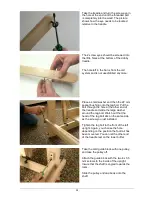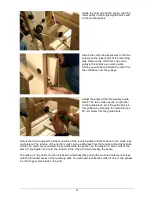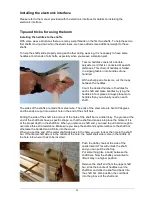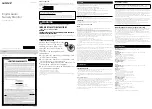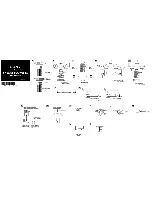
39
blocking plate, the dobby hook remains extended forward and will be picked up by the knife,
making next shed.
One reason why this happens is that the shaft does not go down to its lowest position because it
sticks to a shaft bar of the neighboring shaft. Leave some heddles at the ends of all the shafts. This
will help to guide the shafts along each other. It is also possible that many (unused) heddles close
together on a shaft cause the shaft not to return to the lowest position. Also be sure that the Texsolv
cords run through the slots of the shaft bars.
Another reason for the problem that a screw head does not come high enough to block its non-
selected shaft could be the level adjustment of the shaft in its cords, i.e., the shaft comes back to its
lowest position, but at this position the screw head does not slide over the blocking plate snapping
into the locking position. To check this you need to take the dobby mechanism or interface off the
loom first. When the shafts are in their lowest position, there must be a 2-3 mm (1/16"- 3/32")
clearance between the screw heads and the blocking plate.
If it is necessary to adjust this distance with a shaft, follow this procedure:
To prevent working on the wrong shaft, mark the shaft that needs adjustment with a piece of colored
yarn on both ends. Loosen the small bolts of the clamps that hold the shafts on both sides to the
cords just enough so that the clamps can be moved on the shaft ends. (Please note that the heads
of these bolts require a Phillips screwdriver, not supplied with the loom.) When the bolts are loose,
you can adjust the shaft in relationship to the cords, and by doing so, to the dobby hook. Tighten the
bolts again while the shaft is in its lowest position and the head of the blocking screw is 2-3 mm
(1/16"-3/32") above the blocking plate.
One shaft sticks 10 mm (about 1/2
"
) above the other shafts while it is in its lowest position
Probable cause:
-
You loosened one of the shaft bars on both sides, and by accident, fastened it upside down.
The shed is too small
Possible causes:
-
The knife of the dobby system is adjusted too high. Refer to page 15 for instructions.
-
The beater is adjusted too high.
-
The warp has to be advanced.
-
The cable of the pedal doesn’t run properly around the disk that drives the knife.
One of the treadles cannot be pushed down
Possible cause:
-
Your foot is resting on the other treadle and you have inadvertently blocked the treadle that you
want to operate.
The dobby treadle cannot be pushed in
Possible reason:
-
The spring for the reversing disk sits half way on the guide instead of in the forward or reverse
position.
When you push the shed treadle, there is no shed
Possible causes:
-
The cable of the treadle has become undone.
-
To prevent overheating of the interface, it becomes inactive if you wait a while before making
next shed. Activate the interface again with your software.
-
There are no pegs in the program bar that you just put into position.
While weaving, the tension in the warp changes
Possible causes:
-
The brake cable is not mounted in the correct direction on the disk, see page 17.
-
The brake pedal is adjusted too high and is released by touching the middle section when the
back portion hinges up.
Содержание Octado
Страница 2: ......




